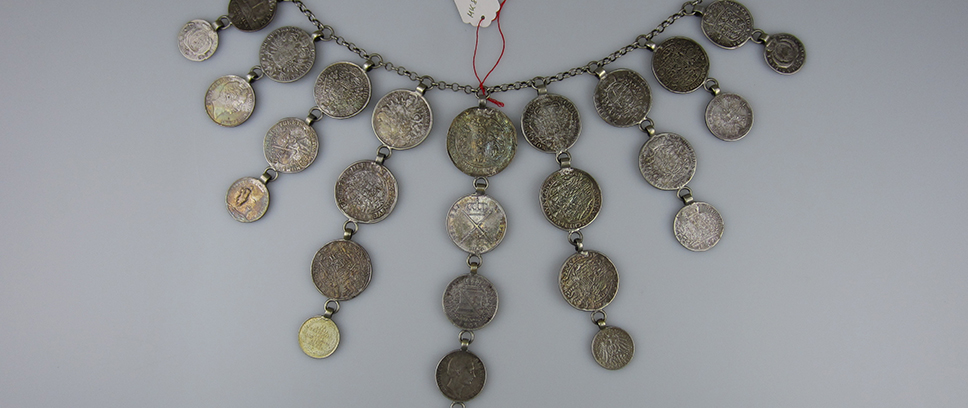
Game Box and Coin Necklace. A look at the museum’s collection activity
Nico Geisen | 13 September 2023
In the collections of the Deutsches Historisches Museum, all the objects are inventoried, but the context of their provenance and usage is not always entirely evident. It is therefore one of the main tasks of the collection trainees to complete the content analysis of these objects. Nico Geisen has occupied himself intensively with two bundles of objects in the collection of applied art, which contains the museum’s artistically designed everyday objects.
One of these objects is a game box, purchased in 2014, which contains 30 boardgame pieces (Inv. Nr. KG 2014/26.1-26.32). The original inventory data indicates that the wooden box, produced around 1700, contains delicate marquetries (inlays) as well as boards for chess, morris and tric-trac, and is thus a fine example of the boardgame tradition. The pieces, which are decorated with portraits of sovereigns and allegorical depictions, are only mentioned in passing in the original inventory data. Hardly any other information was registered until now.

Latin inscription reads in translation: “The cock, oh! It’s hanging,
down, careful, the cat’s going to catch it.” [File: ME00067942]
But the finely worked game pieces in particular contain further information that could be important for future exhibitions. This includes, for example, the method of production. They were made in series using a stamping technique. A wooden beam was first turned to the desired diameter and divided into the required number of wooden workpieces. The workpieces were then placed in a compression press in order to press the depictions onto the front and back sides of the pieces. Wood is only partially suited to this compression procedure, because it is a very fragile material. Due to this production method the game pieces were therefore considered very valuable, even though hard wood such as maple or pear was usually used.[1]
Around 1700, Nuremberg experienced a peak phase in the production of game pieces. At this time the pictures made by the stamp cutter Martin Brunner were widely known. His initials MB are found on most of the game pieces in the bundles of objects discussed here. The pictures served among other things to provide greater entertainment during the games. Alongside portraits of sovereigns, which might have inspired political discussions, many romantic or erotic scenes as well as allegories created an ironic undertone that might have amused the players.
All of the game pieces have meanwhile been systematically registered and photographed. In addition to the basic data, such as production date and producer, the information in the collection database now includes the production method and an overview of the history of the object, including an in-depth iconographic identification of the persons depicted.

A Sorbian wedding necklace (Inv. Nr. MK 83/473), which was acquired in 1983 as an example of Sorbian peasant culture and not further studied after its original inventorisation, was among the objects to be more closely examined. The so-called Šnóra (Sorbian for string) is a coin necklace. Not yet identified were the 28 coins with soldered eyelets that are strung together in nine rows. Most of the coins are from Saxony, but several from Bavaria and Austria are attached. The inscriptions of the sovereigns’ titles, e.g., “D.G.MAX.IOS.U.B.&P.S.D.C.P.R.S.R.I.A.&EL.L.L” [2] are hard to decipher, but offer useful information. For example, in some cases the years in which the coins were circulated can only be estimated on the basis of the respective sovereign pictured on the coin.

The Šnóra is wedding jewellery that was wore in Catholic Sorbian families. For the most part, the first row of coins in a chain was made in the 19th century and then supplemented in the course of time. The necklaces were traditionally passed on to the generation of the daughters and worn at their wedding as part of the traditional attire for such occasions. There is usually no systematic order to the coins.
These and other research findings have now been added to the DHM’s collection database, so that the objects have been thoroughly researched and can be searched directly for future exhibition projects.
[1] A precise description with extensive additional information can be found in the inventory catalogue of the Germanisches Nationalmuseum in Nuremberg: Maué, Hermann, Spielsteine mit Bildern, 16. bis 19. Jahrhundert. Bestandskatalog des Germanischen Nationalmuseums, Nuremberg 2020.
[2] Complete: “Dei Gratia Maximilianus Iosephus Utriusque Bavariae et Palatinus superioris Dux, Comes Palatinus Rheni, Sacri Romani Imperii, Archdapifer et Elector Landgrafius Leuchtenbergii” [Translation: “By the grace of God Maximilian Joseph Duke of Bavaria and Elector of Upper Palatinate and Electoral Palatinate, Imperator of the Holy Roman Empire and Landgrave of Leuchtenberg”]
Nico GeisenNico Geisen works in the Collection at the German Historical Museum. |